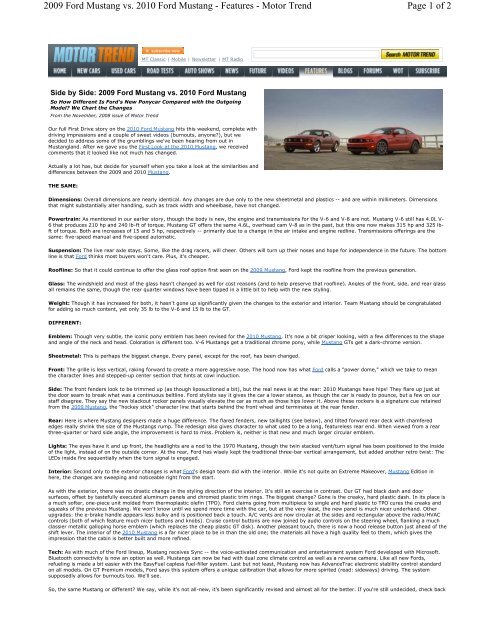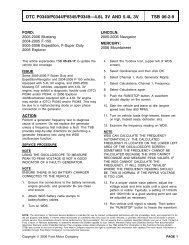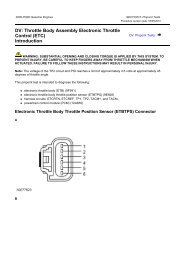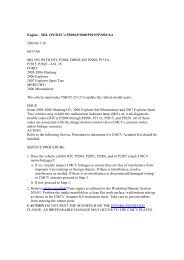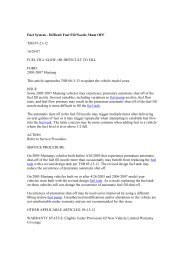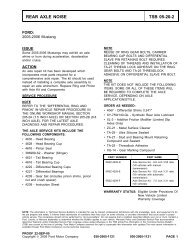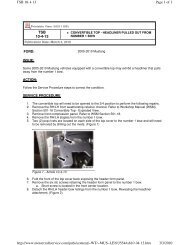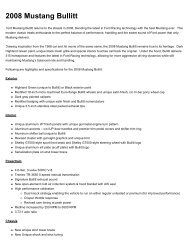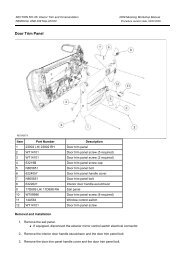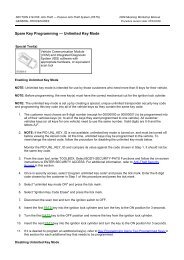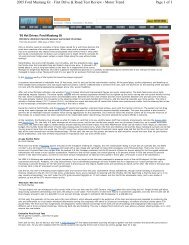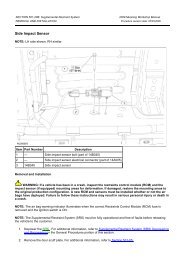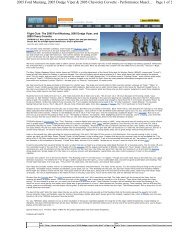Motor Trend - 2009 Mustang GT/CS
Motor Trend - 2009 Mustang GT/CS
Motor Trend - 2009 Mustang GT/CS
You also want an ePaper? Increase the reach of your titles
YUMPU automatically turns print PDFs into web optimized ePapers that Google loves.
<strong>2009</strong> Ford <strong>Mustang</strong> vs. 2010 Ford <strong>Mustang</strong> - Features - <strong>Motor</strong> <strong>Trend</strong><br />
Page 1 of 2<br />
MT Classic | Mobile | Newsletter | MT Radio<br />
Side by Side: <strong>2009</strong> Ford <strong>Mustang</strong> vs. 2010 Ford <strong>Mustang</strong><br />
So How Different Is Ford's New Ponycar Compared with the Outgoing<br />
Model We Chart the Changes<br />
From the November, 2008 issue of <strong>Motor</strong> <strong>Trend</strong><br />
Our full First Drive story on the 2010 Ford <strong>Mustang</strong> hits this weekend, complete with<br />
driving impressions and a couple of sweet videos (burnouts, anyone), but we<br />
decided to address some of the grumblings we've been hearing from out in<br />
<strong>Mustang</strong>land. After we gave you the First Look at the 2010 <strong>Mustang</strong>, we received<br />
comments that it looked like not much has changed.<br />
Actually a lot has, but decide for yourself when you take a look at the similarities and<br />
differences between the <strong>2009</strong> and 2010 <strong>Mustang</strong>.<br />
THE SAME:<br />
Dimensions: Overall dimensions are nearly identical. Any changes are due only to the new sheetmetal and plastics -- and are within millimeters. Dimensions<br />
that might substantially alter handling, such as track width and wheelbase, have not changed.<br />
Powertrain: As mentioned in our earlier story, though the body is new, the engine and transmissions for the V-6 and V-8 are not. <strong>Mustang</strong> V-6 still has 4.0L V-<br />
6 that produces 210 hp and 240 lb-ft of torque. <strong>Mustang</strong> <strong>GT</strong> offers the same 4.6L, overhead cam V-8 as in the past, but this one now makes 315 hp and 325 lbft<br />
of torque. Both are increases of 15 and 5 hp, respectively -- primarily due to a change in the air intake and engine redline. Transmissions offerings are the<br />
same: five-speed manual and five-speed automatic.<br />
Suspension: The live rear axle stays. Some, like the drag racers, will cheer. Others will turn up their noses and hope for independence in the future. The bottom<br />
line is that Ford thinks most buyers won't care. Plus, it's cheaper.<br />
Roofline: So that it could continue to offer the glass roof option first seen on the <strong>2009</strong> <strong>Mustang</strong>, Ford kept the roofline from the previous generation.<br />
Glass: The windshield and most of the glass hasn't changed as well for cost reasons (and to help preserve that roofline). Angles of the front, side, and rear glass<br />
all remains the same, though the rear quarter windows have been tipped in a little bit to help with the new styling.<br />
Weight: Though it has increased for both, it hasn't gone up significantly given the changes to the exterior and interior. Team <strong>Mustang</strong> should be congratulated<br />
for adding so much content, yet only 35 lb to the V-6 and 15 lb to the <strong>GT</strong>.<br />
DIFFERENT:<br />
Emblem: Though very subtle, the iconic pony emblem has been revised for the 2010 <strong>Mustang</strong>. It's now a bit crisper looking, with a few differences to the shape<br />
and angle of the neck and head. Coloration is different too. V-6 <strong>Mustang</strong>s get a traditional chrome pony, while <strong>Mustang</strong> <strong>GT</strong>s get a dark-chrome version.<br />
Sheetmetal: This is perhaps the biggest change. Every panel, except for the roof, has been changed.<br />
Front: The grille is less vertical, raking forward to create a more aggressive nose. The hood now has what Ford calls a "power dome," which we take to mean<br />
the character lines and stepped-up center section that hints at cowl induction.<br />
Side: The front fenders look to be trimmed up (as though liposuctioned a bit), but the real news is at the rear: 2010 <strong>Mustang</strong>s have hips! They flare up just at<br />
the door seam to break what was a continuous beltline. Ford stylists say it gives the car a lower stance, as though the car is ready to pounce, but a few on our<br />
staff disagree. They say the new blackout rocker panels visually elevate the car as much as those hips lower it. Above these rockers is a signature cue retained<br />
from the <strong>2009</strong> <strong>Mustang</strong>, the "hockey stick" character line that starts behind the front wheel and terminates at the rear fender.<br />
Rear: Here is where <strong>Mustang</strong> designers made a huge difference. The flared fenders, new taillights (see below), and tilted forward rear deck with chamfered<br />
edges really shrink the size of the <strong>Mustang</strong>s rump. The redesign also gives character to what used to be a long, featureless rear end. When viewed from a rear<br />
three-quarter or hard side angle, the improvement is hard to miss. Problem is, neither is that new and much larger circular emblem.<br />
Lights: The eyes have it and up front, the headlights are a nod to the 1970 <strong>Mustang</strong>, though the twin stacked vent/turn signal has been positioned to the inside<br />
of the light, instead of on the outside corner. At the rear, Ford has wisely kept the traditional three-bar vertical arrangement, but added another retro twist: The<br />
LEDs inside fire sequentially when the turn signal is engaged.<br />
Interior: Second only to the exterior changes is what Ford's design team did with the interior. While it's not quite an Extreme Makeover, <strong>Mustang</strong> Edition in<br />
here, the changes are sweeping and noticeable right from the start.<br />
As with the exterior, there was no drastic change in the styling direction of the interior. It's still an exercise in contrast. Our <strong>GT</strong> had black dash and door<br />
surfaces, offset by tastefully executed aluminum panels and chromed plastic trim rings. The biggest change Gone is the creaky, hard plastic dash. In its place is<br />
a much softer, one-piece unit molded from thermoplastic olefin (TPO). Ford claims going from multipiece to single and hard plastic to TPO cures the creaks and<br />
squeaks of the previous <strong>Mustang</strong>. We won't know until we spend more time with the car, but at the very least, the new panel is much nicer underhand. Other<br />
upgrades: the e-brake handle appears less bulky and is positioned back a touch. A/C vents are now circular at the sides and rectangular above the radio/HVAC<br />
controls (both of which feature much nicer buttons and knobs). Cruise control buttons are now joined by audio controls on the steering wheel, flanking a much<br />
classier metallic galloping horse emblem (which replaces the cheap plastic <strong>GT</strong> disk). Another pleasant touch, there is now a hood release button just ahead of the<br />
shift lever. The interior of the 2010 <strong>Mustang</strong> is a far nicer place to be in than the old one; the materials all have a high quality feel to them, which gives the<br />
impression that the cabin is better built and more refined.<br />
Tech: As with much of the Ford lineup, <strong>Mustang</strong> receives Sync -- the voice-activated communication and entertainment system Ford developed with Microsoft.<br />
Bluetooth connectivity is now an option as well. <strong>Mustang</strong>s can now be had with dual zone climate control as well as a reverse camera. Like all new Fords,<br />
refueling is made a bit easier with the EasyFuel capless fuel-filler system. Last but not least, <strong>Mustang</strong> now has AdvanceTrac electronic stability control standard<br />
on all models. On <strong>GT</strong> Premium models, Ford says this system offers a unique calibration that allows for more spirited (read: sideways) driving. The system<br />
supposedly allows for burnouts too. We'll see.<br />
So, the same <strong>Mustang</strong> or different We say, while it's not all-new, it's been significantly revised and almost all for the better. If you're still undecided, check back
<strong>2009</strong> Ford <strong>Mustang</strong> vs. 2010 Ford <strong>Mustang</strong> - Features - <strong>Motor</strong> <strong>Trend</strong><br />
Page 2 of 2<br />
Saturday at 12:01 a.m. for our story on how it drives.<br />
Home | New Cars | Used Cars | Car Reviews | Auto Shows | Future Cars | Car Prices | Car Pictures | Auto Rebates | Site Map<br />
© 2010 <strong>Motor</strong><strong>Trend</strong> Magazine,<br />
Source Interlink Media<br />
All rights reserved. WEB-044<br />
Dealer | Car Dealers | Car Insurance | Used Car Dealers | MT Classic | Subscribe | Give a Gift | Subscriber Services<br />
Espanol | | Partners | Licensing | Reprints |<br />
User Submitted<br />
Content<br />
|<br />
Privacy<br />
Policy<br />
|<br />
Terms of<br />
Use<br />
|<br />
Contact<br />
Us


